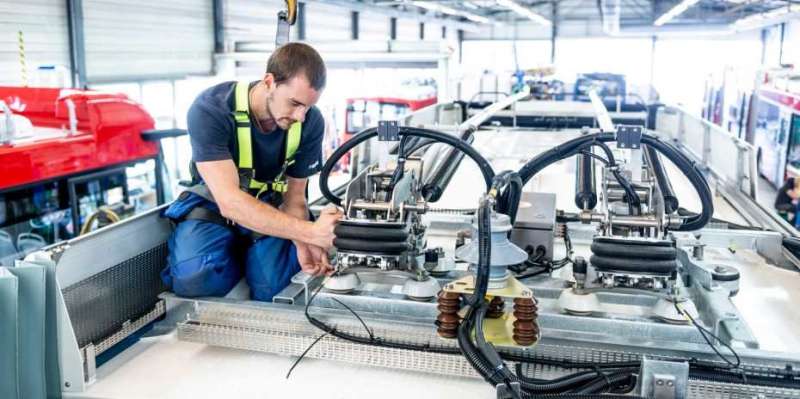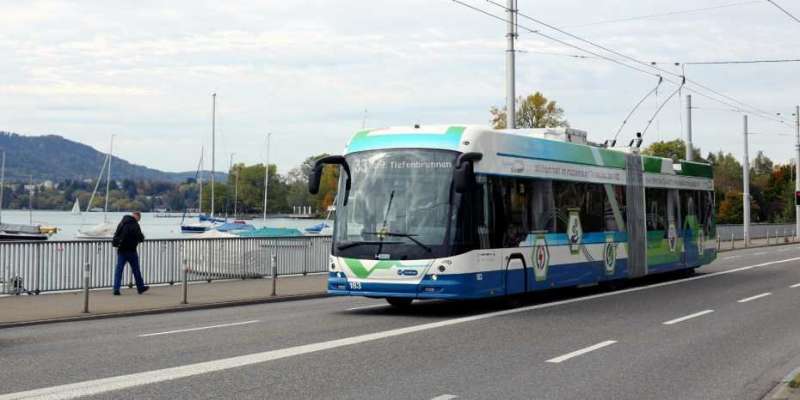Research helps make buses smarter

A rather unusual trolleybus has been navigating the streets of Zurich in recent months. With its large windscreen and covered wheels, it could easily be mistaken for a tram – but it's not just the design that makes this bus so unique. For a start, it features a hybrid electric drive system that allows it to draw power from an on-board traction battery as well as overhead wires. But this bus is also "smart", boasting specially designed software that automatically gathers information on the route. That means it always knows what to expect – whether that's a downhill stretch or a dead wire up ahead.
This intelligent city bus is the result of a joint project between ETH and the Swiss SME Carrosserie HESS, which is headquartered in Bellach in the canton of Solothurn. Carrosserie HESS is Switzerland's only bus manufacturer – and ETH has developed an energy management software package tailored to its needs. Using algorithms, the software determines when the bus should alternate between the overhead wires and battery pack by identifying the optimum source of power at each particular moment. For example, during a hill climb the most sensible choice is to drain the traction battery, because the bus can subsequently take advantage of regenerative braking on a downhill stretch to recharge the battery "for free". This method can reduce energy use by up to 15 percent, which translates into considerable cost savings.
Competitive advantage
This collaborative project offers advantages on both sides. HESS benefits from a capacity for innovation that would be inconceivable without a research partner. "We simply don't have the resources to develop that kind of efficient energy management system on our own," says Martin Widmer, who is responsible for the project at Carrosserie HESS. Working with ETH has allowed the Swiss company and its approximately 260 employees to maintain a competitive edge over far bigger rivals from other countries.
For their part, ETH researchers are able to translate their theoretical expertise into concrete projects. The scientific complexities of hybrid buses are a good choice of topic for contributions to academic journals, says Christopher Onder, Professor at the Institute for Dynamic Systems and Control at ETH. "The project attracts students like a magnet," he adds, noting that the joint projects carried out with HESS to date have already yielded some 30 semester projects and Bachelor's and Master's theses. What's more, a number of students have already completed an internship at HESS, while others such as Martin Widmer have taken on permanent positions at the SME after finishing their degree at ETH.

Putting theory into practice
ETH and Carrosserie HESS began working together in 2009. At that time, HESS was experimenting with a diesel hybrid bus, but the energy savings they were achieving were lower than they had hoped for. So when ETH came up with the idea of developing a new energy management system for the bus project as part of a doctoral position, the HESS project coordinators jumped at the chance. The doctorate was funded by the Swiss Commission for Technology and Innovation CTI and the Swiss Federal Office of Energy.
There was still quite a way to go before the first bus with ETH software rolled off the HESS production line. From the research side, the project was a resounding success that produced some major fuel savings – but by the time the doctoral thesis was finished, the balance of customer demand had shifted from diesel hybrid buses to electric buses. This brought home the challenges that arise in any partnership between academia and the private sector, with the slow mill of ETH's scientifically rigorous approach on the one hand, and Carrosserie HESS's exposure to market dynamics on the other. "What we need is not necessarily a system that is theoretically perfect, but one that works in practice and complies with all the regulations," says Widmer. "And obviously it has to eventually make us some money!"
A project with a future
"SwissTrolley plus" is a follow-up project involving the latest electric bus from HESS – and both partners have learned from experience. Once again, a doctoral student at ETH is developing a software program for efficient energy management. But what's new is that this project brings on board a second research institute in the form of Bern University of Applied Sciences, as well as its first public transport operator in the form of Verkehrsbetriebe Zürich (VBZ). As a result, the ETH researchers can analyse the software in real-world conditions practically on their doorstep, thanks to the pilot bus that VBZ added to its Zurich fleet some 12 months ago.
Right now, the smart Zurich pilot bus is the only one of its kind – but not for long. This autumn, three more bi-articulated buses based on the same technology will start operating on local routes. And back at Carrosserie HESS Widmer is confident that other public transport operators will soon follow suit: "A few of them have already expressed interest".
This second joint doctoral project comes to an end next year, but there's a good chance the cooperation between ETH and HESS will continue in the future. The longer their collaboration lasts, the more issues they find that can best be solved by working together. "Software could potentially help out not just with the driving, but also save energy used for heating and air conditioning," says Widmer. ETH Professor Onder agrees without hesitation: "That's definitely an interesting and relevant area for researchers to look into."
Provided by ETH Zurich




















